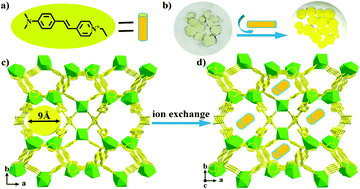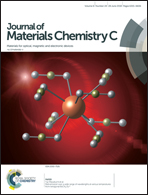Stable dye-encapsulated indium–organic framework as dual-emitting sensor for the detection of Hg2+/Cr2O72− and a wide range of nitro-compounds†
Abstract
A water-stable porous anionic metal–organic framework (MOF), [(CH3)2NH2][In(TNB)4/3]·(2DMF)(3H2O) (1, H3TNB = 4,4′,4′′-nitrilotribenzoicacid), was synthesized. Through ion-exchange method, one dual-emitting composite 1⊃DSM was prepared with the encapsulation of cationic dye 4-[p-(dimethylamino)styryl]-1-ethylpyridinium (DSM). 1⊃DSM exhibits sensitive quenching response towards Hg2+ and Cr2O72− ions in aqueous solution. In particular, the detection limit of Hg2+ is as low as 1.75 ppb, which is among the lowest values for MOF-based probes. Moreover, 1⊃DSM shows remarkable sensitivity for nitro-explosives in a wide scope, particularly for phenol hydroxyl-containing nitro-explosives. Furthermore, 1⊃DSM has a broad response to nitroimidazole-based antibiotics at low concentrations. As a result, the incorporation of DSM into MOF could strikingly improve the sensitivity and range of the detection. In addition, the orbital energy theoretical calculation and UV-Vis absorption experiments confirmed that the quenching performances could be mainly attributed to the electron transfer and resonance energy transfer effect between the framework, DSM and the analytes.



 Please wait while we load your content...
Please wait while we load your content...